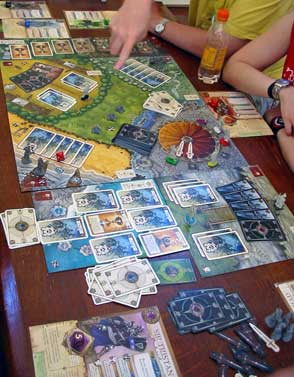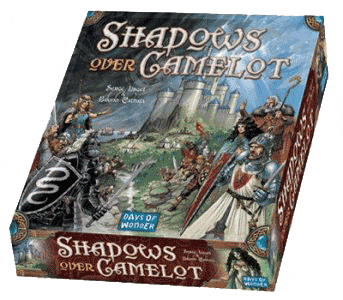The latest in this line is the new game from Days of Wonder, Shadows over Camelot, which looks set to be another winner for this young company. Designed by Bruno Cathala and Serge Laget, the game is set in the world of Arthurian legend. King Arthur, the Round Table and the quest for the Holy Grail all play their part in the game. And the biggest challenge for players is to refrain from Monty Python and the Holy Grail references. Or not, if they prefer. As you’d expect the players are all Knights of the Round Table. The names are familiar: Gawain, Kay, Percival and so on – including Arthur himself (but not, of course, Sir Not-appearing-in-this-game. Sorry, I’ll try to refrain). Each Knight has his own special ability, summary card (the illustration shows King Arthur as an example), a die in his colour and a playing piece. One of the attractions of the game is that the playing pieces are nice model figures and there are also models for the enemy Picts and Saxons and the objects of Quests. The Knights start in Camelot at their seats around the Round Table. This is the largest of the several boards in the game, showing Camelot, the field in front of it, the tourney field where the Black Knight awaits and the gathering forces of Picts and Saxons. The other boards show the other quests: for the Holy Grail, for Excalibur and to recover Lancelot’s armour (which has a quest against a Dragon on the reverse). The heart of the game is the Round Table in Camelot, however. As quests are resolved, the segments of the Round Table fill up with swords – chunky cardboard pieces. If the Knights succeed in a quest, the swords are white side up; the black side is face up if they failed. The game ends when there are at least 12 swords on the table and the good guys triumph if white swords are in the majority. Of course, it ain’t that simple. To start with, succeeding in a quest is a real challenge. They are resolved through card play. There are two decks of cards in the game: white cards for the Knights to use (including a very useful Merlin card each) and black ones for the forces of darkness. Knights on a quest play the White cards, while Black cards are drawn at random and added to the quest they apply to. The quests work differently, but essentially there have to be more white cards (in number or value) than black. What makes winning a quest really difficult is that players can be generating as many Black cards as they are able to play White ones! This is because drawing Black cards is integral to the play of the game. The first thing a player does each turn has to be something to “progress Evil” and is usually drawing a Black card. The card is usually added to a specific quest, making it harder for the Knights to succeed. Only then does the Knight get to play a white card, which goes towards completing the quest, or carry out some other action. As you can see, this doesn’t give the good guys much of an edge. Strategy for the Knights, as a group, is thus about concentrating on quests they can win. Most of the quests allow several Knights to work together. This gives them a much better chance of success, but does mean that other quests have to be ignored. The Knights need to decide what to go for (such as the quest for the Grail, which will bring in several white swords) and what to leave. In the first place, the choice will depend on the cards the Knights have available. If they hold lots of Grail cards, the quest for the Holy Grail is the obvious target. However, the Black cards drawn will change things. For example, if a sequence of Black cards is drawn for the Excalibur quest when no Knights are there, the quest is in danger of failing. Should Knights stop what they’re doing and rush to try to save Excalibur? Decisions, decisions… As individuals, the Knights can also choose to do something other than drawing a black card each turn. One option is to place a catapult (more nice models) on the board. There is room for a dozen of these outside the walls of Camelot and they can also appear through the draw of a card. However, if all the spaces are ever filled, the game ends immediately and the Knights lose. Knights can choose to do battle against the catapults to reduce their number. This doesn’t gain any white swords, but it can stave off defeat! Another option is for a Knight to lose a life point instead of drawing a black card. Of course each Knight only has a limited number of these and running out takes the Knight out of the game. Dying nobly in the cause may sound a good way to go, but it leaves the good team short of a member. Succeeding in a quest can give Knights extra life points and the Grail, once found, can be used to restore a dying Knight to health. The other use of life points is to allow a Knight to take a second action in his turn (though this can’t be the same as his first action). This can be quite useful, but should be used sparingly – ideally to complete a quest when extra life points will be dished out.  Individual turns are very short. A Knight first does something to advance the dark side (draw a Black card, place a catapult, lose a Life Point). Then he moves (to or from Camelot) or plays a card (if on a quest) or picks up cards (if in Camelot). He also gets to use his special ability, if appropriate. But that’s it. This means that the game zips along and your next turn comes round quickly. The rules suggest that any negotiation and co-operation between the Knights is done in character. The intent is clearly to limit the extent the players work together – though co-operation is vital if they are to win the game. It also adds an explicit role-playing element to the game, which players can play up to or not as they see fit. This brings us to the biggest twist in the game: one of the Knights may be a traitor! At the start of the game, each player takes a loyalty card, which s/he keeps hidden. All but one of the cards show that the Knight is true and loyal. As there are always more cards than players (though you can change this if you want to), there is a chance that nobody is a traitor. Naturally, everybody assumes there is a traitor. The traitor wins, of course, if Camelot falls or the game ends without a majority of white swords on the Round Table. And if the traitor is undetected at the end of the game, s/he switches two swords from white to black – potentially reversing the whole result! This gives a whole new dimension to the game (think Werewolf/Mafia) and adds a big competitive component. Not only do the Knights have to win, they have to win by a big margin or unmask the traitor. Wrongly accusing someone turns a sword black, though, so the good guys need to be pretty sure. And all the time the traitor is working against them. Which may give the traitor away or may be so subtle that no-one notices. The suspicion (paranoia?) between the players, knowing that one of them may be a traitor, puts a brake on the extent of the co-operation. There’s a competitive element in the game after all and this is what makes it so good – and very different from Lord of the Rings. It’s not simply a case of maximising the usefulness of the set of cards held between all the players. It is about individuals deciding the extent to which they will co-operate and with whom. Cracking stuff – and the best evidence of this is what happens if half a dozen people sit down and play the game for the first time. When they’ve finished, what’s the first thing they’ll do? Play it again! What better recommendation could you have? Shadows over Camelot was designed by Bruno Cathala and Serge Laget and
published by Days of Wonder. It’s a co-operative strategy board game for 3-7
players and takes around 90 minutes to play (though it can be longer if the
Knights bicker!). It is readily available in UK shops. | Pevans |
 There has long been a strand within games publishing of
games – often aimed at children – that are co-operative. That is, the players
work together against the game mechanics or to complete some task. The best
known example of this in recent years is the Lord of the Rings board
game designed by Reiner Knizia and published by Sophisticated Games (and
licensed to Hasbro and Kosmos amongst others). (Personally, I’m not convinced
this is really a game, but it’s certainly a great experience.)
There has long been a strand within games publishing of
games – often aimed at children – that are co-operative. That is, the players
work together against the game mechanics or to complete some task. The best
known example of this in recent years is the Lord of the Rings board
game designed by Reiner Knizia and published by Sophisticated Games (and
licensed to Hasbro and Kosmos amongst others). (Personally, I’m not convinced
this is really a game, but it’s certainly a great experience.)